View in other NatureServe Network Field Guides
NatureServe
Montana
Utah
Wyoming
Idaho
Wisconsin
British Columbia
South Carolina
Yukon
California
New York
Tadpole Physa - Physella gyrina
Other Names:
Physa gyrina
Native Species
Global Rank:
G5
State Rank:
SNR
(see State Rank Reason below)
Agency Status
USFWS:
USFS:
BLM:
External Links
State Rank Reason (see State Rank above)
Currently this species is found state-wide and in a variety of habitats often in large densities.
General Description
This ubiquitous, left-handed snail species is distributed in temerpate and sub-Arctic North America from southern Alaska and northwestern Canada (but not in the extreme north) east and southeast to central Labrador, western New England and the vicinity of New York City; south to central California, Nevada, Utah, and Colorado (Taylor 2003). (Burch 1989) lists several supposed synonyms including Physella gyrina gyrina from Canada, Quebec to Ontario south to Nebraska and east to New York. This snail can be found in a variety of habitats from lakes, ponds, streams, ditches, and marshes (Taylor 2003). Like most snails, these are herbivorous-scrapers of algae, detritus and diatoms from vegetation and off other benthic substrates.
Diagnostic Characteristics
If live specimens are being evaluated, this species may be distinguished from P. acuta easily by looking at the animals’ bodies. P. gyrina has very obvious whitish pigment spots on a dark grey ground, over the whole body including the tentacles, whereas P. acuta lacks spotting and ground color is more variable ranging from a pale grey to blue-grey or even black. The spire of P. gyrina is conical, flat sided, and the sutures between whorls is shallower, while the shell of P. acuta has a more rounded spire with less steep angles
Species Range
Montana Range
Range Descriptions
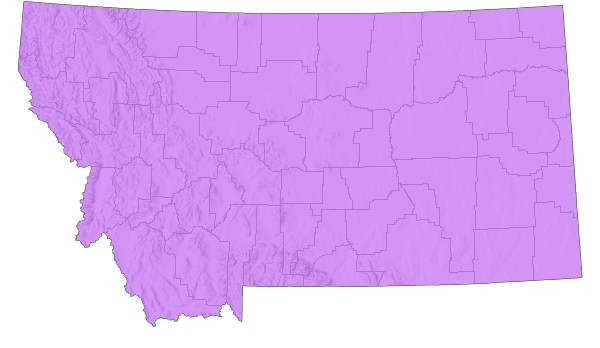
 Native
Native
Range Comments
Currently this species is found state-wide.
Observations in Montana Natural Heritage Program Database
Number of Observations: 220
(Click on the following maps and charts to see full sized version)
Map Help and Descriptions
Relative Density
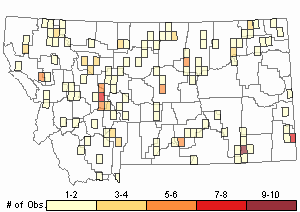
Recency
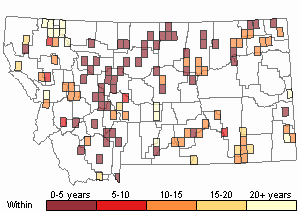

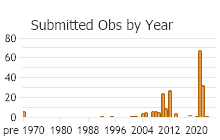
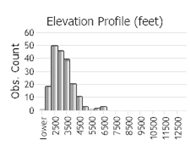 (Observations spanning multiple months or years are excluded from time charts)
(Observations spanning multiple months or years are excluded from time charts)
Migration
No populations of this species make local extended movements (generally less than 200 km) at particular times of the year (e.g., to breeding or wintering grounds, to hibernation sites).
Habitat
P. gyrina tends to live in clear to turbid waters in the marginal zones of large lakes, ponds, and rivers and can be found in the shallow margins or in marshy pools along shorelines
National Vegetation Classification System Groups Associated with this Species
Wetland and Riparian
Alkaline - Saline Wetlands
Alpine Riparian and Wetland
Peatland
Riparian and Wetland Forest
Wet Meadow and Marsh
Food Habits
Like most snails, these are herbivorous- scrapers of algae, detritus and diatoms from other vegetation of benthic substrates
Ecology
P. gyrina tends to live in clear to turbid waters in the marginal zones of large lakes, ponds and rivers and can be found in the shallow margins or in marshy pools along shorelines
Stewardship Responsibility
References
- Literature Cited AboveLegend:
 View Online Publication
View Online Publication Burch, J.B. 1989. North American freshwater snails. Malacological Publications: Hamburg, Michigan. 365 pp.
Burch, J.B. 1989. North American freshwater snails. Malacological Publications: Hamburg, Michigan. 365 pp. Taylor, D.W. 2003. Introduction to Physidae (Gastropoda: Hygrophila); biogeography, classification, morphology. Revista de biología tropical, 51, pp.1-+.
Taylor, D.W. 2003. Introduction to Physidae (Gastropoda: Hygrophila); biogeography, classification, morphology. Revista de biología tropical, 51, pp.1-+.
- Additional ReferencesLegend:
 View Online Publication
View Online Publication
Do you know of a citation we're missing? Berry, S.S. 1913. A list of Mollusca from the Mussellshell Valley, Montana. Nautilus 26:130-131.
Berry, S.S. 1913. A list of Mollusca from the Mussellshell Valley, Montana. Nautilus 26:130-131. Berry, S.S. 1916. Notes of Mollusca of central Montana. Nautilus 29:124-128.
Berry, S.S. 1916. Notes of Mollusca of central Montana. Nautilus 29:124-128. Gillespie, D.M. 1966. Population studies of four species of mollusks in the Madison River, Yellowstone National Park. Ph.D. Dissertation. Bozeman, Montana: Montana State University. 43 p.
Gillespie, D.M. 1966. Population studies of four species of mollusks in the Madison River, Yellowstone National Park. Ph.D. Dissertation. Bozeman, Montana: Montana State University. 43 p. Gore, J. A. 1976. In-stream flow requirements of benthic macroinvertebrates in a prairie river. M.A. thesis. University of Montana, Missoula, MT.
Gore, J. A. 1976. In-stream flow requirements of benthic macroinvertebrates in a prairie river. M.A. thesis. University of Montana, Missoula, MT. Heaton, J.R. 1966. The benthos and drift fauna of a riffle in the Madison River, Yellowstone National Park. Ph.D. Dissertation. Bozeman, Montana: Montana State University. 59 p.
Heaton, J.R. 1966. The benthos and drift fauna of a riffle in the Madison River, Yellowstone National Park. Ph.D. Dissertation. Bozeman, Montana: Montana State University. 59 p. Hendricks, P., S. Lenard, D.M. Stagliano, and B.A. Maxell. 2013. Baseline nongame wildlife surveys on the Fort Peck Indian Reservation. Report to the Assiniboine and Sioux Tribes of the Fort Peck Indian Reservation. Montana Natural Heritage Program, Helena, MT. 83 p.
Hendricks, P., S. Lenard, D.M. Stagliano, and B.A. Maxell. 2013. Baseline nongame wildlife surveys on the Fort Peck Indian Reservation. Report to the Assiniboine and Sioux Tribes of the Fort Peck Indian Reservation. Montana Natural Heritage Program, Helena, MT. 83 p. Lehmkuhl, Dennis M. 1966. A study of the littoral invertebrates of three mountain lakes in Glacier National Park, Montana. M.A. Thesis. University of Montana. Missoula, MT.
Lehmkuhl, Dennis M. 1966. A study of the littoral invertebrates of three mountain lakes in Glacier National Park, Montana. M.A. Thesis. University of Montana. Missoula, MT. Russell, R.H. and R.B. Brunson. 1967. A check-list of molluscs of Glacier National Park, Montana. Sterkiana 26:1-5.
Russell, R.H. and R.B. Brunson. 1967. A check-list of molluscs of Glacier National Park, Montana. Sterkiana 26:1-5. Squyer, H. 1894. List of shells from the vicinity of Mingusville, Montana. The Nautilus 8:63-65.
Squyer, H. 1894. List of shells from the vicinity of Mingusville, Montana. The Nautilus 8:63-65.
- Web Search Engines for Articles on "Tadpole Physa"
- Additional Sources of Information Related to "Snails / Slugs"





